Posts from Rob Meek (meek)
Dear FontStructors,
FontStruct is currently on tour in Granada, Spain. On a cool but bright spring morning, I’m sitting in a roof garden in the old Arab quarter, the Albayzín, staring at the magnificent medieval, hill-top palace of the Nasrid dynasty: the Alhambra.
About 700 years ago, the finest arab mathematicians and local craftspeople joined forces here and colluded to create the complex, honeycomb ceilings for the sultan’s private chambers. Selecting and arranging from a limited array of simple, geometric building-blocks the architects created a dizzying, recursive edifice, like a vast, heavenly city suspended over the visitor’s heads.
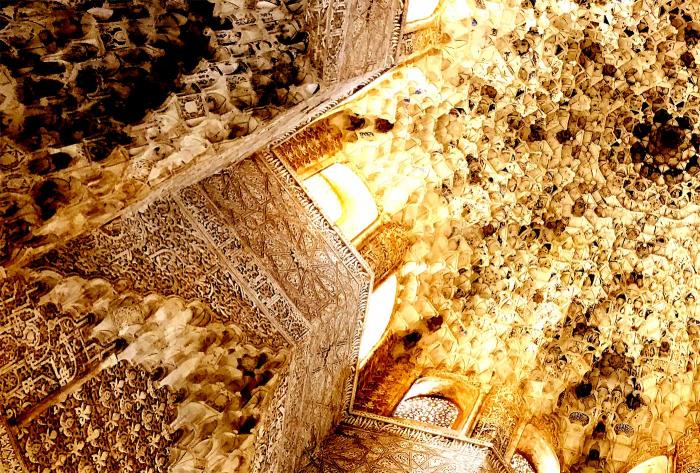
▲ Ceiling in the Palace of the Lions (the Alhambra)
Were these designers, perhaps, the first FontStructors? Did they love and curse their little prismatic “Muqurnas” shapes and their limitations just as we love and curse our bricks? Did they leap up and scream with joy when they discovered a hitherto unthought-of combination of forms? If you are a FontStructor who has visited the Alhambra yourself you may well feel empathy with its architects’ profound passion for geometry; their predilection for modular building techniques and their love of decorative scripts.
Continue reading…
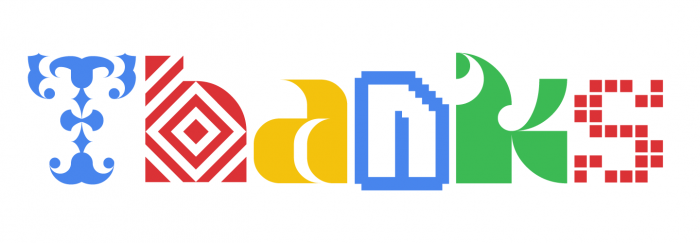
Dear FontStructors,
Today, with FontStruct’s tenth anniversary imminent, we’re delighted to announce that Google Fonts will be our principal sponsor in 2018.
Introducing the SIL Open Font License
As part of their sponsorship, Google Fonts are helping us to implement a new open-source licensing option on FontStruct – The SIL Open Font License (OFL) – which we’re adding to FontStruct today:

The OFL is an open-source license, designed specifically for open-source fonts, and is suitable for designers who would like to make their work freely available with zero restrictions on use, modification or distribution.
Contribute to Google Fonts
But this is more than just another option in the licensing menu.
The OFL is the preferred license for contributions to Google Fonts’ renowned and robust directory of open-source, designer, web fonts; so it’s just become much, much easier to contribute your designs directly from FontStruct to Google Fonts.
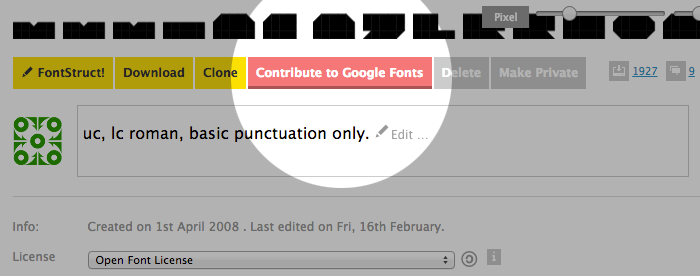
At time of writing, there are few (if any?) modular, grid-based fonts on Google Fonts. We’re eager to see the first FontStructions appearing on fonts.google.com in 2018, and we hope that some of you will soon be enjoying the massive, global exposure and the state-of-the-art, zero-cost, webfont-delivery service that Google Fonts provides.
How can I contribute my FontStruction to Google Fonts?
To get started, your FontStruction needs to fulfil a few basic criteria, including:
- It must be an original design, and of good quality (the ultimate judges of this are the Google Fonts team).
- It must be licensed under the OFL.
- It must contain, as a minimum, the 215 glyphs listed by Google. (with the exception of the last 3). You’ll notice these glyphs are now listed as a special character set in the FontStructor.
- It must have a simple and unique name, with no copyright or trademark infringements, no initials and no abbreviations.
Once everything is ready, you can use the new “Contribute to Google Fonts” button on your FontStruction homepage to start the contribution process.
Helpful Resources
You will find a new section in our FAQ with a detailed, step-by-step guide to help you get started with contributing your FontStruction to Google fonts. Please read this guide thoroughly before proceeding. There’s also a dedicated contact channel for any further questions on this topic.
We’re looking forward to a very exciting year.
Happy FontStructing!
FontStruct would like to thank our sponsors: Google Fonts – Making the web more beautiful, fast, and open through great typography, and Creative Fabrica – your number #1 source for premium design elements.

Thanks to everyone for another fantastic year of FontStructing.
Special thanks to the FontStructors featured in our holiday sample above:
To funk_king for Ornaments – a wonderful collection of festive baubles.
To sorbilicious for “an old story by sorbilicious” – a magical blackletter
and to jirinvk for jaubolAC24 for an idiosyncratic A that’s also both a christmas tree and a wrapped present.
Happy Holidays Everyone!
FontStruct would like to thank our sponsor: Creative Fabrica – your number #1 source for premium design elements.
Oh FontStructors,
Will you ever disappoint? This time you were faced with what seemed, at first glance, a relatively staid and technical theme: “serif”. Nevertheless you rose to the challenge, with your inimitable imagination and energy – endlessly riffing, playing and transmogrifying to produce a magnificently rich and diverse array of 58 entries – a record haul for a FontStruct competition. Many thanks and congratulations to everyone who entered.
Judging was more difficult than ever, but, thanks to the excellent input of our guest judge beate, we finally reached consensus.
First up, and in no particular order, the four winning entrants:

G1 Radia was a unanimous choice of the judges. With it’s high-contrast strokes, ball-terminals and discreet little serifs this FontStruction genuinely radiates a curvesome beauty, although on closer inspection one also sees intriguing traces of its cruder, modular roots.
All four winners actually made multiple high-quality entries, some of which we couldn’t resist including in the samples, so below G1 Radia you can also marvel at the monumental G1 Valora – one of the serifiest serifs this side of the Pecos.
2. Hoek by four (shown in red)

Hoek was elected by the FontStruct community as the “people’s favorite” . It obviously stems from a clear and precise concept for a bevelled slab, thoughtfully executed in every perfect detail.
In fact, the judges were even more excited by the highly-inventive “elza” (the second design featured above) in which wiry strokes terminate in a questioning hook-shape rather than a traditional serif or terminal. Planetarium, also shown above, was another strong and popular slab entry.

The judges were enchanted by Cembrel B: a subtle, attractive, and eminently-usable, high-contrast serif, part of a developing new family. Nouveaumbre was another really excellent entry from yautja.
And last but not least …

A classifier’s nightmare: a slab serif concealed inside a sans! – what an innovative interpretation of the theme. Beyond the high concept, architaraz also succeeds in delivering a coherent and attractive typeface. Beneath AT Bals you can see the elegant inline ”AT Migdalia” with it’s hairline serifs.
Many, many congratulations to our four prizewinners.
Some Honorable Mentions:

– A classic serif with an unusual calligraphic twist, created on a pin-board matrix.

– A convivial, super-chunky slab-serif, given added character by the idiosyncratic snips in certain letter-tops.

– Actually I’m not sure whether this is (at least in any sense known to me) a serif, but a strong, clear design nevertheless.

– One of three strong entries from the master of the dotted font. Some really charming glyphs in this one.

– Ultra-high-contrast strokes and serifs in a stencil-flavoured entry.

– Calculated, cutout crudity. Shamelessly modular and yet also wonderfully imperfect.

This brutal disfiguration of an existing design by Sychoff came very close to a prize. Although tagged as punk, there’s also something quite primitive and ancient going on here. I can see these glyphs scratched into the base of an amphora, or perhaps arranged in the border of a mosaic. Compare the Jekyll to this Hyde.
Congratulations again to all winners, who will be contacted about their prizes in the next few days; thanks to our judges; and, most of all, thanks to everyone who took part. I look forward to our next competition.
Happy FontStructing!
Rob
FontStruct would like to thank our sponsor: Creative Fabrica – your number #1 source for premium design elements.
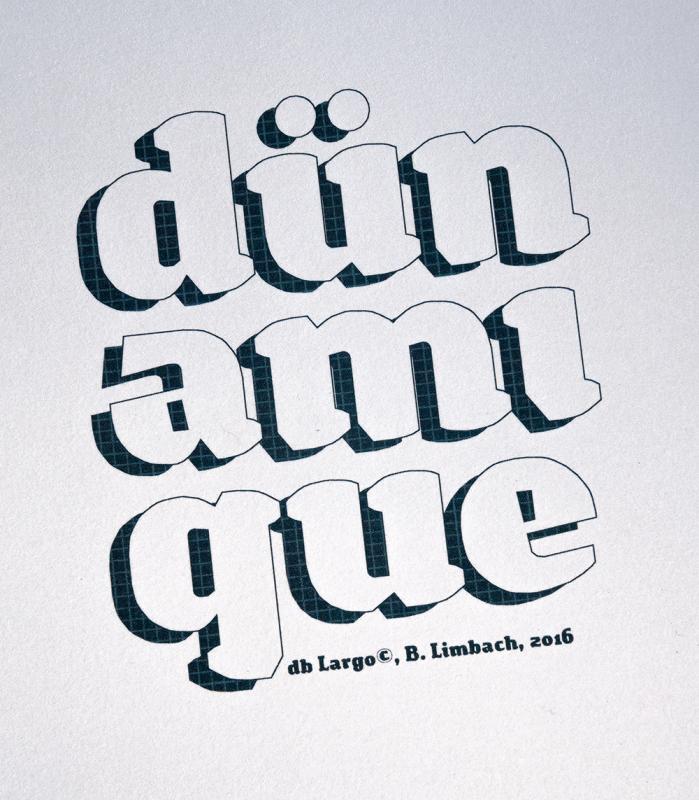
Many years have passed since I felt remotely able to answer the question “How did they do that?” in regard to most of the finest and complex designs on FontStruct. Our community of ingenious designers, the “FontStructors”, have long been the true adepts, the rightful owners of the grid and the brick. But who are they?
In 2009 Yves Peters tried to answer this question in his excellent series of 7 interviews “Focus on FontStructors”.
A resumption of his project, eight years on, is long overdue, and today we’re making a start by talking to one of FontStruct’s exceptional stars of recent years; record winner of no less than three FontStruct competitions, hoarder of staff picks, and designer of some of FontStruct’s most extraordinary fonts: Beate Limbach …

FS: Beate, please tell us a bit about yourself. Where do you live and work? What kind of training do you have? What do you do in everyday life beyond FontStructing?
I was brought up in Giessen, Germany.
After graduating from secondary school, I studied art theory and Romance studies in Kassel, Paris and Mainz.
In 2006, I completed my degree in communications design at the University of Applied Science Mainz, studying under Professor Johannes Bergerhausen, and focusing on book design (typography) and photography.
For a little more than 10 years, I’ve been living and working as a freelance designer in Lausanne in Switzerland. Typography is a passion that has gripped me since my schooldays, and in recent years I’ve shifted my professional focus from print design to type design.
How did you become interested in type and typography? What was your first experience of font design?

– The victor’s booty from three FontStruct competitions.
My first contact with the world of type and calligraphy was at primary school where I encountered various different forms of standardised handwriting, and learnt about the transition from the old “Sütterlin” form of handwriting to the latin form in German schools. Later, I had the opportunity to take part in a calligraphic drawing course. The posters we made on this course were screen-printed and so I learned about an additional design medium which, in turn, fuelled my interest in graphic design more generally.
During my studies I had the opportunity to work on Johannes Berghausen’s “decodeunicode” project as it was still in its very early stages. The project’s aim was the researching of all the characters and alphabets included within Unicode – their histories, significance and use. It’s since developed into a wonderful online platform for pure typographic research.
FS: How did you start out on FontStruct?

– db For You and db Largo in use
In 2008, while browsing for free fonts, I stumbled upon articles about FontStruct in Smashing Magazine and I Love Typography. I was excited by the idea of being able to design typefaces in a playful way and with a minimal toolset. I also liked the fact that one had control over how to license designs.
Before FontStruct I had experience with lettering and “analogue” type design, but I’d barely come into contact with digital, type-design software. FontStruct was a way-in for me to gradually start exploring this world.
I began to work with other type-design software, both in order to refine and extend my “FontStructions”, and to develop new fonts outside FontStruct. Several of my FontStruct fonts where published in the Typodariums between 2014 and 2016 and this led to interest and customers for fonts such as db Drops, db Soda, db Como Splitt and db Bargo.
FS: If you had to choose two (or three) of your own FontStructions as favourites, which would they be and why?
That’s not easy – there are so many more than just three! But I would choose db For You (script), db Largo (heavy serif) und db Bargo Condensed (light, handwritten sans).

I designed db For You for the FontStruct “Love Competition” in 2016. My first thought on the theme was that love letters are very personal and are usually handwritten, so I decided to make a script font. To avoid the letters appearing too smooth and cute, I added a rough, irregular contour. Through small variations in the stroke-width this special ductus developed which also resembled a handwritten flow. (I’d already tried out this technique in 2013 when designing db Bargo.) The overall result is a script font which is not just suitable for the screen. It’s important to me that my fonts are also applicable in print design.

db Largo was created at the same time as db For you in 2016. db Largo combines serifs and calligraphic elements. The font isn’t completely polished but it’s little imperfections lend it a relaxed, friendly appearance and dynamic. db Largo is eminently usable for short texts or headlines.
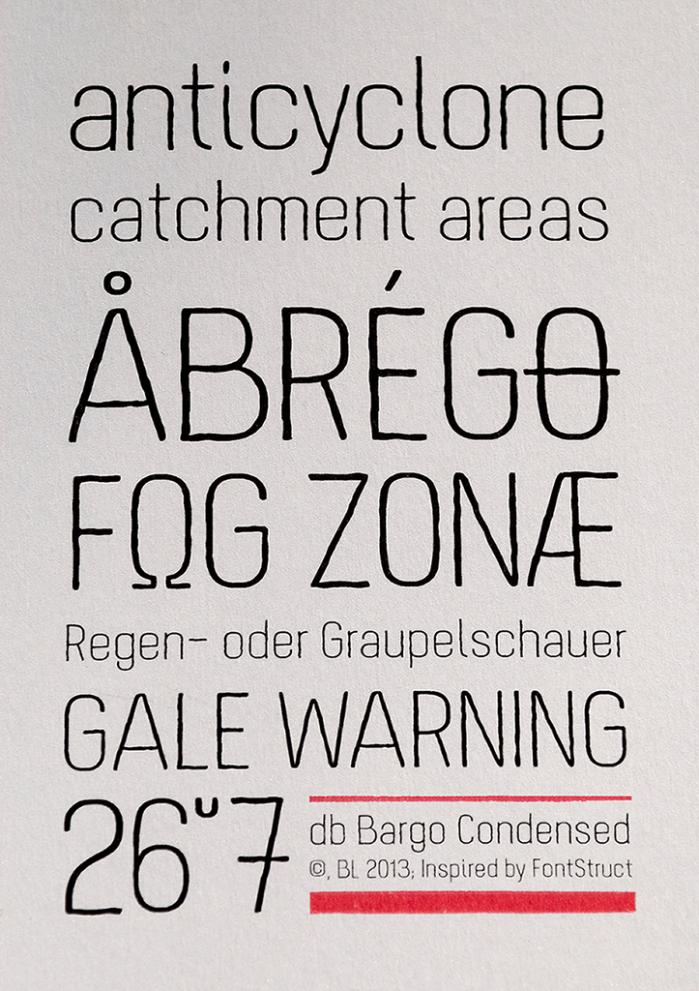
I built db Bargo in 2013. It’s based on a condensed grotesque, and combines geometry and optimised legibility with individual aspects of a handwritten sans. db Bargo is marked by it’s simple structure and low contrast. This font is also perfect suited to headlines, typographic posters, T-shirts and other print applications.
FS: What other work on FontStruct do you especially admire and why?
Spontaneously I think of Aphoria’s fonts. I really like the relaxed style of his ideas and designs on FontStruct. His work is marked by an incredibly assured, balanced and coherent formal language. I particularily like the San Serif fonts Uptake and Obleak, as well as the Blackletter Futility.
I’m also impressed by the fonts of Frodo7, thalamic/minimum and four. I find Frodos 3D series Rohan and the slab serif Esgaroth genuinely expressive and extremely well thought-through, as are the heavy sans fs Bored and tm Blooper from thalamic. I’m fascinated by four’s outline fonts which seem unsurpassable in the richness of their variation and subtle refinement; they demonstrate how little complexity one needs in order to give a font a unique character.
FS: What are the aspects of FontStruct that make it appealing to you?
I think FontStruct is a unique web-platform for free and creative font design. I never cease to be excited by the formal richness of some FontStructions – despite the fact that, at the end of the day, they’re all just combinations and arrangements of geometrical “bricks”. And then there are the additional tools and functionality in “expert mode” which have been added over the years and which have enhanced the creative possibilities.
Using FontStruct just never gets boring. From the very beginning, my curiosity has been piqued and my ambition stoked by the challenge of exploring new approaches and formal languages in FontStruct. What continues to stimulate me is the desire to look more closely and to pay more attention to those little, inconspicuous details which give a typeface its overall character, its “polish”.
FS: If you could add or improve one thing on FontStruct, what would it be?

I think the creation of some kind of FontStruct foundry would be interesting – a forum where the best Fontstructions could be promoted or even sold. From my own experience, I think the potential and demand are there. Perhaps it would be a new incentive for everyone working creatively and constructively on FontStruct, to allow them to market their designs on the same platform on which they were created.
Thanks beate! Please explore more of beate’s work on FontStruct or visit her design studio website.
All images copyright Beate Limbach.
Interview translated from German by Rob Meek.
FontStruct would like to thank our sponsor: Creative Fabrica – your number #1 source for premium design elements.
Dear FontStructors,
It’s time for our second competition of the year, this time on the theme of “serif”.
Competition Brief
Our theme is the serif: “a small line attached to the end of a stroke in a letter or symbol” as wikipedia describes it – so your designs should focus on these strokes in some way or form. Serifs come in various shapes – Old-style, Didone, Slab and others. You can use any type(s) of serif you wish in your competition entries. Perhaps you could even devise a new serif form of your own.

FontStructors specialize in extravagant and experimental display fonts, so feel free to place your serifs in the foreground – they don’t have to be small as wikipedia suggests.
For typographic inspiration, please take a look at our Serif and Slab Serif category pages.
Competition Time Period
Wednesday, 8th November 2017 – Saturday 2nd December, 2017
Competition Rules
- You must be a registered FontStruct user.
- Your submission(s) must be posted and made “public” between 8th November 2017 and 2nd December, 2017. Although you are encouraged to share your submission(s) at any time between these dates, your FontStruction submission(s) must be public (marked “share with everyone”) no later than 2nd December, 2017 at 11pm PST. Additionally, your submission(s) must remain public at least until 9th December 2017 in order to give the judges enough time to review all qualifying entries.
- Your submission(s) must be tagged with a “Serifcomp” tag. (For fairness, during the competition time period, no FontStruction with the “Serifcomp” tag will be awarded a Top Pick.)
- Your submission(s) must be downloadable. If your FontStruction cannot be downloaded, the submission will not be including in the judging.
- Your submission must be a newly published FontStruction. Simply adding the “Serifcomp” tag to an already published font is not allowed.
- For each submission, you must post at least one sample image in the comments of the FontStruction.
- No letters in each submission can be MORE THAN 48 grid squares high.
- FontStruct cloning is permitted but the judges will be looking for original work.
- You may enter up to three FontStructions to the competition.
- This is a friendly competition. Cheering, favoriting and fun banter is encouraged but cruel and uncivil behavior will not be tolerated.
- No rules regarding licensing. You may choose any license you like for your FontStruction.
Judging and announcing the winners
All qualifying FontStructions will by judged by the FontStruct staff and guest judges between December 2nd and December 9th. Three prizewinners will be chosen. One of these will be the FontStructors’ Favourite. Winners will be announced in a FontStruct Blog post on Monday December 11th.
Prizes
Each winner can choose a t-shirt printed with a FontStruction glyph of their choice.
FontStructors’ Favourite
The valid entry with the greatest number of legitimate favourites at 11pm PST on 9th December 2017 will be one of the three prizewinners.
Questions?
If you have questions just add them as comments to this post.
May the best FontStruction win.
FontStructions in header image are clockwise from the top left: db Boxer Slab by beate, Manuale Neue Bold by laynecom, one-horse town by four, zeamróg-eYe/FS by elmoyenique, Unknownim by architaraz and RM Victoriana by p2pnut.
FontStruct would like to thank our sponsor: Creative Fabrica – your number #1 source for premium design elements.
Dear FontStructors,
How’s your typographic mood?
Looking to head West perhaps? Keen to explore the 1920s, the 1990s or the dark ages? Feeling dotty or groovy or dark? We have something for every temper and whim …
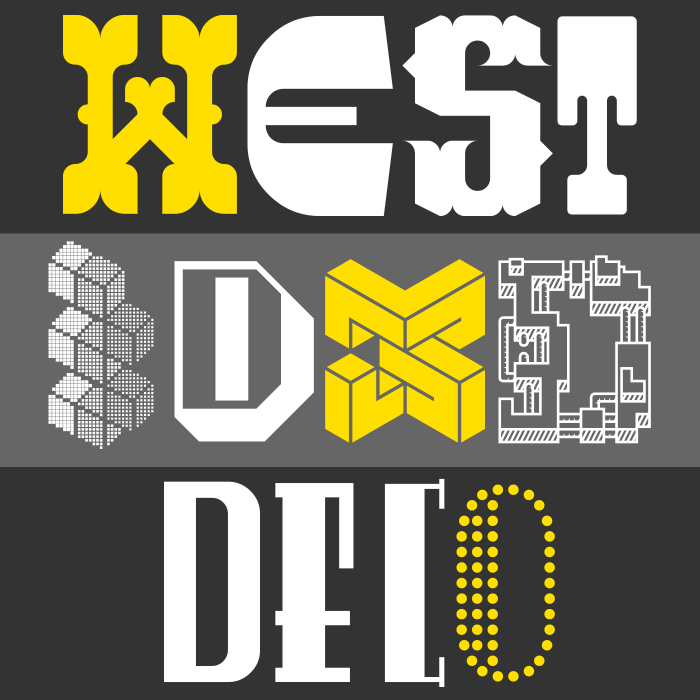
Today we’re launching a new kind of gallery feature called FontStruct Sets.
The first sets to be released include: “Wild West”, “3D”, “Art Deco”, “Dotted”, “Dot Matrix”, “Groovy”, “Grunge”, “Heavy”, “Lineal” and “Handwritten”
As our unique archive of modular creativity grows, we need to find new ways to curate it, so that we, and visitors to our site, can find the kind of fonts we’re looking for more easily.
Our broad categories (sans, serif etc) are a useful filter, as are the community-created tags, and of course the recently revamped search box; but as time has gone on we’ve noticed clear sets of related FontStructions emerging in the gallery which, until now, haven’t been adequately organised.
Sets are more specific than categories, and, because they’re manually curated by FontStruct staff, they’re more consistent than tags and search results. Until now we’ve prepared about 80 sets, and we’ll be gradually extending and releasing them over the next few months.
Sets are accessible via the little turquoise tags which appear next to the relevant FontStruction in the gallery.
Happy Exploration and FontStructing!
Stop Press: FontStruct would like to welcome and thank our new sponsor: Creative Fabrica – your number #1 source for premium design elements.
What a wonderful competition.
Yet again the FontStruct community has demonstrated its unbounded creativity in interpreting a difficult theme in diverse and original ways. I would encourage everyone to have a close look at each of the entries, many of which really only reveal their conceptual secrets and precious details upon closer examination.
While the winners are doubtlessly worthy ones, there could easily have been many, many more, so don’t be too downhearted if you didn’t win, and please pity the judges their impossible task.
Before we announce the winners,
Some Honorable Mentions:

A number of designers decided to explore reversal in the sense of symmetry. ben17’s reflection for example (above), which despite the high concept manages to be legible and strikingly attractive, or architaraz’s similarly practical and well-formed AT Imago Reversed which is also an ingenious mirroring stencil:


Also playing with symmetry and continuing a distinctive FontStruct tradition of esoteric, decorative glyph sets is “Charm Spells” by Aeolien: Every glyph a mystery, like ancient lines scratched in the desert:

“tm up dn” by thalamic is an ingenious attempt to build a usable letter set by rotating or flipping other glyphs – both a crazy catalogue of intentional mistakes, and a clever way to explore new forms:

geneus1 gave us, as so often before, several strong and original entries, including the intricately woven G1 Trushae. Chainmail? alien circuitry? noodles? I’m not sure which it reminds me of more, but everyone is invited to lose themselves in the artistry:

With “SbB Codebreaker”, Sketchbook B demonstrates that it’s possible to execute an original concept using only the simplest of materials – the pixel brick. It’s a strange and very technical FontStruction but as the designer himself notes, it has a pleasing and distinctive texture:

There were so many other great entries, equally deserving of mention, but at some point we must move on to …
The Winners
The FontStructor’s Favourite was AT Esrever by architaraz. A clear and clever concept, perfectly executed and the favourite of our community:
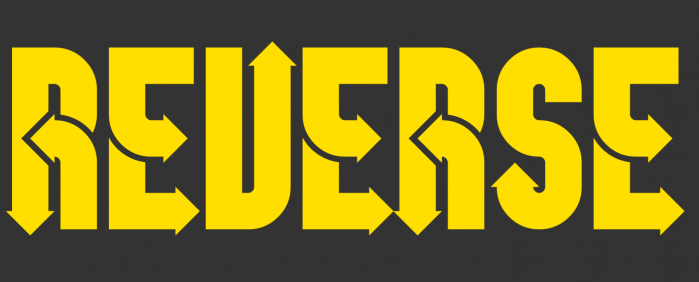
A favourite of both judges was the cleverly named counter culture by four which opens an intriguing orthographic window on negative space. The dot-screen shading is a lovely detail.

zelbod eYe/FS by elmoyenique is a good example of a FontStruction which doesn’t reveal its full quality at the standard sizes used to display it in the Gallery and elsewhere on FontStruct.
zelbod has to be seen at a large point size in order for the unique folding concept and fine shading pattern to reveal their beauty:
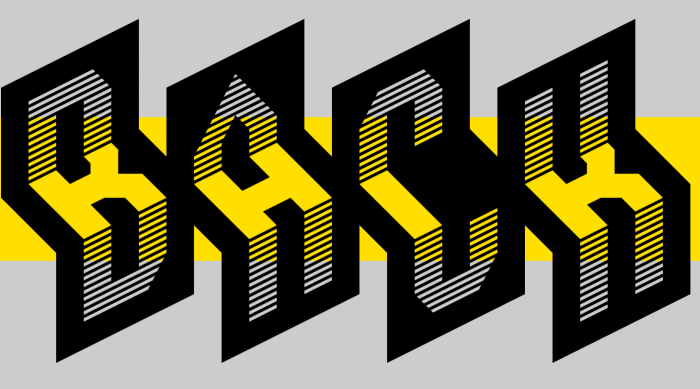
Finally, I forgot, again, to invite beate to join the judging panel for this competition, and so, with three more spectacular entries, a prize is once more heading in her direction. We chose the elegantly carved db Jojo as our favourite:

Congratulations to each of the prizewinners; you will be contacted regarding your prizes shortly.
Congratulations also to EVERYONE who participated. It’s truly a great pleasure to see all your work appearing and growing on the site.
Special Thanks
To our guest judge, Stephen Coles of LetterForm Archive, Fonts In Use, Typographica, and on fortunate occasions such as this, FontStruct.
Now it’s time to wipe off our trowels and return to our hods. There are bricks to be laid.
Happy FontStructing!

“When I am drawing letters, I use the same approach. I am drawing the white shapes not the black strokes.”
– Cyrus Highsmith in “Eye Magazine”
Dear FontStructors,
Peace, love and fair bricks to you all.
By popular demand, and with all the additional bricks and other improvements in the HTML5 FontStructor, it’s high time for a new competition.
The theme this time around is “Reverse” which you are welcome to understand in any sense e.g. inverted, backwards, opposite, negative, or however else you wish to interpret it – literally or metaphorically.
Remember to tag your entry with “Reversecomp” before the 8th of July and don’t forget to upload a sample image.
Before starting, please read the rules below carefully, even if you are a frequent FontStructor.
Competition Time Period
Monday, 19th June 2017 – Saturday 8th July, 2017
Competition Rules
- You must be a registered FontStruct user.
- Your submission(s) must be posted and made “public” between 19th June 2017 and Saturday 8th July, 2017. Although you are encouraged to share your submission(s) at any time between these dates, your FontStruction submission(s) must be public (marked “share with everyone”) no later than 8th July, 2017 at 11pm PST. Additionally, your submission(s) must remain public at least until 15th July 2017 in order to give the judges enough time to review all qualifying entries.
- Your submission(s) must be tagged with a “Reversecomp” tag. (For fairness, during the competition time period, no FontStruction with the “Reversecomp” tag will be awarded a Top Pick.)
- Your submission(s) must be downloadable. If your FontStruction cannot be downloaded, the submission will not be including in the judging.
- Your submission must be a newly published FontStruction. Simply adding the “Reversecomp” tag to an already published font is not allowed.
- For each submission, you must post at least one sample image in the comments of the FontStruction.
- No letters in each submission can be MORE THAN 48 grid squares high.
- FontStruct cloning is permitted but the judges will be looking for original work.
- You may enter up to three FontStructions to the competition.
- This is a friendly competition. Cheering, favoriting and fun banter is encouraged but cruel and uncivil behavior will not be tolerated.
- No rules regarding licensing. You may choose any license you like for your FontStruction.
Judging and announcing the winners
All qualifying FontStructions will by judged by the FontStruct staff and guest judges, July 8th–15th. Three prizewinners will be chosen. One of these will be the FontStructors’ Favorite. Winners will be announced in a FontStruct Blog post on Monday July 17th.
Prizes
Each winner can choose a t-shirt printed with a FontStruction glyph of their choice.
FontStructors’ Favorite
The valid entry with the greatest number of legitimate favorites at 11pm PST on 15th July 2017 will be one of the three prizewinners.
Questions?
If you have questions just add them as comments to this post.
May the best FontStruction win.
FontStructions in header image are, from left to right, fs Unstruct by William Leverette (will.i.ૐ), Negative Shadow by Kai Harrison, zouvenir2U eYe/FS by elmoyenique, Upside Down by cmunk, paper cut by ben17, inverted by cmunk and Bloxed by cayo.
Dear FontStructors,
Today we’re introducing a couple of enhancements to the FontStructor editor.
New “Connecting” Brick Pack
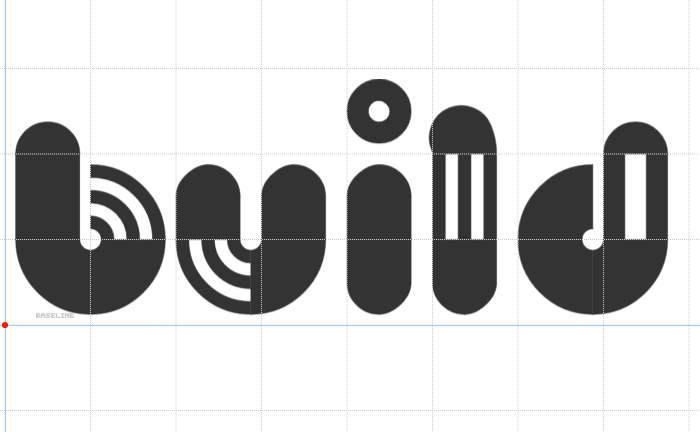
Firstly, we’re adding 58 new bricks to FontStruct.
As the number of available bricks has increased over the years, and with the addition of these new bricks, we’ve decided to break up the “All Bricks” palette into multiple pages or “packs”.
“All Bricks” is now named simply “Bricks” and the currently selected pack is shown in the palette title. Just click on the down arrow to switch packs.
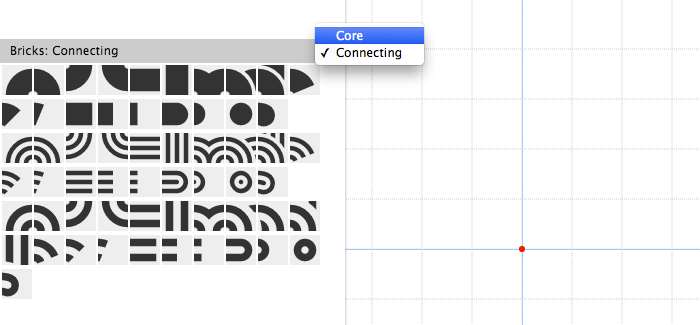
The classic, core bricks will be remain in the default “Core” pack, but now you also have access to the new “Connecting” pack.
The connecting pack includes monoline, biline and triline shapes, curves, lengths, terminals and miscellaneous connectors, which join perfectly and easily with one another. It’s a fun and novel FontStructing experience.
Note that in order for the junctions between these new bricks to match, the connecting points need to be centred within each grid square, so a small gap always remains, to the left and below your designs.
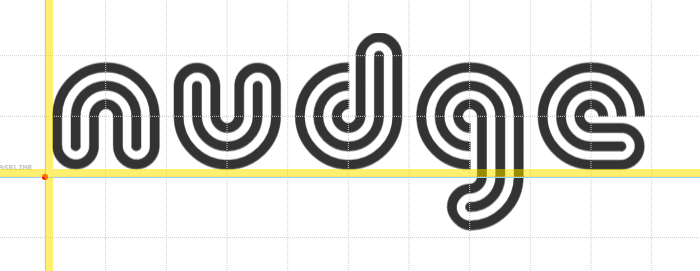
To compensate for this you can use the nudge tool (expert mode) to nudge your glyphs, so that they line up with the origin.
I look forward to seeing what our community can create with these new raw materials. We may add a few more bricks to the connecting pack in the coming weeks.
No more default “Cycle” pen
This has been a very long time coming I know. Now, finally, the standard “simple” pen is the default pen type in the FontStructor, and the cycle pen is an option.
Happy FontStructing!












































